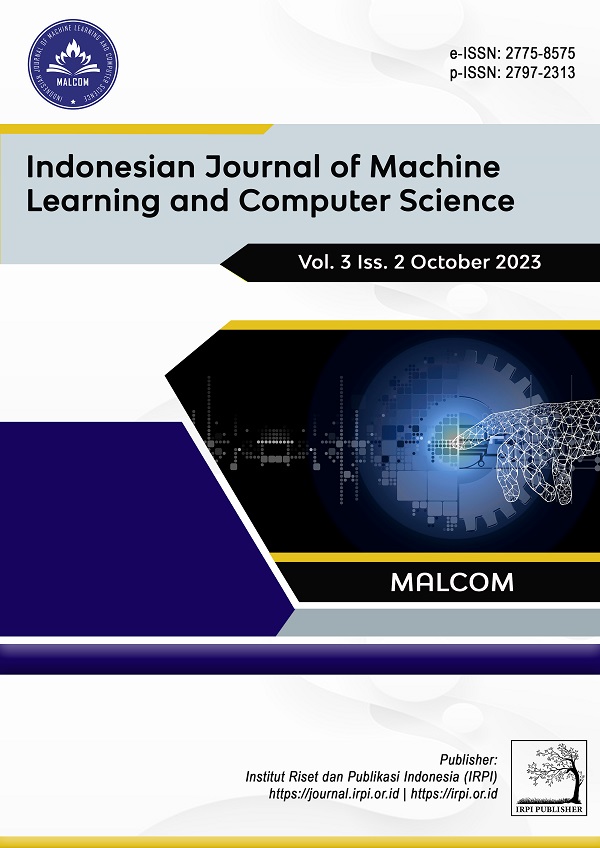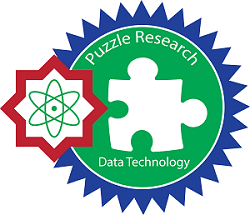Fuzzy Clustering-Based Grouping for Mapping the Distribution of Student Success Data
DOI:
https://doi.org/10.57152/malcom.v3i2.1227Keywords:
Clustering, Fuzzy C-Means, Silhouette Index, The Success of StudentsAbstract
Learning activities are the main activity in the overall teaching and learning process in schools. This is because whether or not the achievement of educational goals depends on how the learning process is carried out by students. The uneven level of student success in learning is one of the problems in the school's efforts to realize the vision and mission of SMKN 5 Pekanbaru in preparing skilled graduates to be able to work in certain sectors by the public interest and the industrial world. In this study, mapping and grouping student grade data was carried out using the Fuzzy C-Means algorithm to provide information to the school in making the right decisions and optimizing the learning process. Furthermore, clustering was carried out in several experiments K=3 to K=7, and obtained the best validity value tested with the Silhouette Index of 0.4277 located at K=5. Then the distribution of cluster 5 on student score data was obtained with details, namely cluster 1 with a capacity of 1 student, cluster 2 with a capacity of 27 students, cluster 3 with a capacity of 1 student, cluster 4 with a capacity of 10 students, cluster 5 with a capacity of 23 students.
Downloads
References
R. Maulana, N. Dwiyani, “Web Usage Mining Menggunakan K-Means untuk Mengetahui Kecenderungan Akses Pengguna (Studi Kasus: Ganto. Co)", Jurnal Vocational Teknik Elektronika dan Informatika, vol. 6, no. 2, 2018.
J. Triwidianti, S. Yanto, and M. Prasojo, “EasyChair Preprint Comparison of Data Mining Methods for Predictive Achievement of Vocational Middle Education Students at State Vocational School (SMKN 1) Gadingrejo Pringsewu Lampung,” 2021.
W. Masrul, H. Silva, and T. Sundari, “Pelatihan Sketch Up Untuk Guru SMKN 5 Pekanbaru Pada Jurusan Desain Permodelan Dan Informasi Bangunan,” COMSEP: Jurnal Pengabdian Kepada Masyarakat, vol. 3, no. 2, 2022.
T. Nabillah and A. P. Abadi, “Prosiding Seminar Nasional Matematika dan Pendidikan Matematika Sesiomadika,” 2019.
D. Transaksi Bongkar Muat di Provinsi Riau, I. Kamila, U. Khairunnisa, P. Studi Sistem Informasi, and F. Sains dan Teknologi UIN Sultan Syarif Kasim Riau, “Perbandingan Algoritma K-Means dan K-Medoids untuk Pengelompokan,” Jurnal Ilmiah Rekayasa dan Manajemen Sistem Informasi, vol. 5, no. 1, pp. 119–125, 2019.
H. J. Kim, J. W. Baek, and K. Chung, “Associative Knowledge Graph Using Fuzzy Clustering and Min-Max Normalization in Video Contents,” IEEE Access, vol. 9, pp. 74802–74816, 2021, doi: 10.1109/ACCESS.2021.3080180.
R. Sanjaya and Y. Nataliani, “Perbandingan Pembobotan Kriteria dan Seleksi Kriteria pada Pengelompokan Kinerja Karyawan dengan Fuzzy C-Means 1.”
A. Jaini, A. Weni Syaputri, T. Qurahman, S. Thaufik Rizaldi, P. H. Studi Sistem Informasi Fakultas Sains dan Teknologi Universitas Islam Negeri Sultan Syarif Kasim Riau Jl Soebrantas Km, and P. Pekanbaru Riau, “Perbandingan Algoritma Fuzzy C-Means dan K-Medoids untuk Pengelompokan Data Penjualan pada 212 Mart,” 2020.
I. P. Sari, A.-K. Al-Khowarizmi, and I. H. Batubara, “Cluster Analysis Using K-Means Algorithm and Fuzzy C-Means Clustering For Grouping Students’ Abilities In Online Learning Process,” Journal of Computer Science, Information Technology and Telecommunication Engineering, vol. 2, no. 1, pp. 139–144, 2021.
J. Nurkholis, K. Oktafianto, H. Thohari, P. Studi Matematika, F. Universitas PGRI Ronggolawe, and S. Negeri, “CLUSTERING DATA KENAIKAN KELAS SISWA MADRASAH TSANAWIYAH (MTs) MENGGUNAKAN METODE FUZZY C-MEANS (STUDI KASUS MTs PLUS AL AMIN BANJAREJO),” vol. 04, no. 01, pp. 11–18, 2022.
I. Singh, S. Sabitha, T. Choudhury, A. Aggarwal, and B. K. Dewangan, “Mapping Student Performance With Employment Using Fuzzy C-Means,” International Journal of Information System Modeling and Design (IJISMD), vol. 11, no. 4, pp. 36–52, 2020.
S. Sarah, “Analisis Penerimaan Vaksin Covid-19 Berbasis Fuzzy Clustering Machine Learning di Provinsi Riau,” Jurnal Riset Komputer), vol. 8, no. 6, pp. 2407–389, 2021, doi: 10.30865/jurikom.v8i6.3636.
H. S. Firdaus, A. L. Nugraha, B. Sasmito, M. Awaluddin, and C. A. Nanda, “PERBANDINGAN METODE FUZZY C-MEANS DAN K-MEANS UNTUK PEMETAAN DAERAH RAWAN KRIMINALITAS DI KOTA SEMARANG,” 2021.
N. Ulinnuha, “Provincial Clustering in Indonesia Based on Plantation Production Using Fuzzy C-Means,” ITSMART: Jurnal Teknologi dan Informasi, vol. 9, no. 1, pp. 8–12, 2020.
S. Kurniawan, A. Siregar, and H. Novita, “Penerapan Algoritma K-Means dan Fuzzy C-Means Dalam Mengelompokan Prestasi Siswa Berdasarkan Nilai Akademik,” Scientific Student Journal for Information, Technology and Science, vol. 4, no. 1, pp. 73–81, 2023.
D. P. Sari, F. Sembiring, D. P. Sulisdianto, Y. Jentiner, and E. Suratno, “Implementasi Algoritma Fuzzy C-Means Untuk Memprediksi Faktor Siswa Membolos (Studi Kasus: Faktor Siswa Membolos Di Smpn 1 Parakansalak),” Jurnal RESTIKOM: Riset Teknik Informatika dan Komputer, vol. 2, no. 1, pp. 1–7, 2020.
K. Sinaga and K. Handoko, “IMPLEMENTASI DATA MINING UNTUK MEMPREDIKSI KELULUSAN SISWA DENGAN METODE NAÏVE BAYES,” 2021.
F. A. Khan, K. Zeb, M. Al-Rakhami, A. Derhab, and S. A. C. Bukhari, “Detection and Prediction of Diabetes Using Data Mining: A Comprehensive Review,” IEEE Access, vol. 9. Institute of Electrical and Electronics Engineers Inc., pp. 43711–43735, 2021. doi: 10.1109/ACCESS.2021.3059343.
Z. Li, C. Tang, X. Liu, X. Zheng, W. Zhang, and E. Zhu, “Consensus Graph Learning for Multi-View Clustering,” IEEE Trans Multimedia, vol. 24, pp. 2461–2472, 2022, doi: 10.1109/TMM.2021.3081930.
M. Mustakim, S. Fitri Octavia, “Penerapan K-Means dan Fuzzy C-Means untuk Pengelompokan Data Kasus Covid-19 di Kabupaten Indragiri Hilir,” Technology and Science (BITS), vol. 3, no. 2, 2021, doi: 10.47065/bits.v3i2.1005.
M. H. Qasem, N. Obeid, A. Hudaib, M. A. Almaiah, A. Al-Zahrani, and A. Al-Khasawneh, “Multi-Agent System Combined with Distributed Data Mining for Mutual Collaboration Classification,” IEEE Access, vol. 9, pp. 70531–70547, 2021, doi: 10.1109/ACCESS.2021.3074125.
I. Irwan, S. Sidjara, and A. P. Aryati, “Pengelompokan Jenis Penerimaan Pajak di Kota Makassar Menggunakan Fuzzy Clustering,” Euler?: Jurnal Ilmiah Matematika, Sains dan Teknologi, vol. 10, no. 1, pp. 98–102, May 2022, doi: 10.34312/euler.v10i1.14225.
D. S. Rohmah, D. Retno, and S. Saputro, “Clustering Data dengan Algoritme Fuzzy c-Means Berbasis Indeks Validitas Partition Coefficient and Exponential Separation (PCAES). PRISMA, Prosiding Seminar Nasional Matematika,” vol. 3, pp. 58–63, 2020, [Online]. Available: https://journal.unnes.ac.id/sju/index.php/prisma/
D. Fitrianah, W. Gunawan, and R. Algian Kurniaputra, “Techno Xplore Jurnal Ilmu Komputer dan Teknologi Informasi Implementasi Algoritma DBScan dalam Pemngambilan Data Menggunakan Scatterplot.”
Mustakim, M. Z. Fauzi, Mustafa, A. Abdullah, and Rohayati, “Clustering of Public Opinion on Natural Disasters in Indonesia Using DBSCAN and K-Medoids Algorithms,” in Journal of Physics: Conference Series, IOP Publishing Ltd, Feb. 2021. doi: 10.1088/1742-6596/1783/1/012016.
G. Ghale, “Peningkatan Hasil Belajar IPA Pada Siswa Kelas VI SDK Wologeru Melalui Model POE (Predict Observed Explain).”
P. Studi and T. Informatika, “DATA MINING UNTUK MEMPREDIKSI PRESTASI MAHASISWA INSTITUT BISNIS DAN INFORMATIKA KOSGORO 1957 BERDASARKAN SOSIAL EKONOMI ORANG TUA DAN PRESTASI MASA LALU,” vol. 2, no. 2, pp. 60–71, 2021.
S. Anwar, T. Suprapti, G. Dwilestari, I. Ali, P. Studi Rekayasa Perangkat Lunak Jln Perjuangan No, and B. Kesambi Kota Cirebon, “PENGELOMPOKKAN HASIL BELAJAR SISWA DENGAN METODE CLUSTERING K-MEANS Program Studi Sistem Informasi Jln Perjuangan No 10B Kesambi Kota Cirebon 4),” Jurnal Sistem Informasi dan Teknologi Informasi), vol. 4, no. 2, pp. 60–72, 2022.
B. G. Sudarsono, M. I. Leo, A. Santoso, and F. Hendrawan, “ANALISIS DATA MINING DATA NETFLIX MENGGUNAKAN APLIKASI RAPID MINER,” JBASE - Journal of Business and Audit Information Systems, vol. 4, no. 1, Apr. 2021, doi: 10.30813/jbase.v4i1.2729.
G. Seroklinov and A. Goonko, “Comparative analysis of experimental data clustering in MATLAB and Python environment,” in E3S Web of Conferences, EDP Sciences, 2023, p. 02025.
Downloads
Published
How to Cite
Issue
Section
License
Copyright © by Author; Published by Institut Riset dan Publikasi Indonesia (IRPI)
This Indonesian Journal of Machine Learning and Computer Science is licensed under a Creative Commons Attribution-ShareAlike 4.0 International License.




















